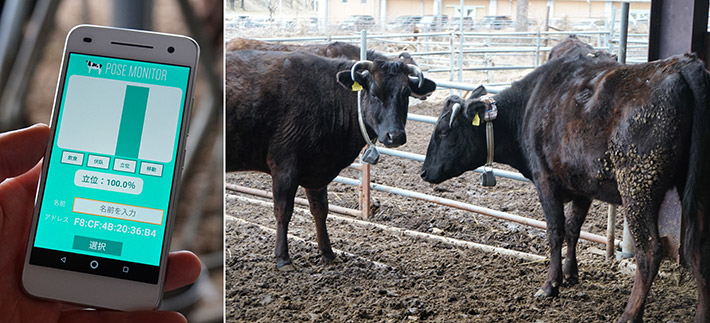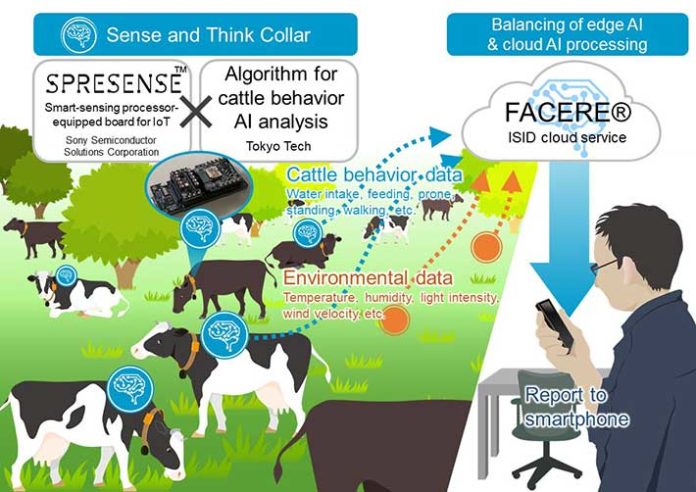A joint project team led by Tokyo Institute of Technology (hereinafter, “Tokyo Tech”), Shinshu University and Information Services International-Dentsu, Ltd. (hereinafter, “ISID”) developed cattle observing systems equipped with a “Sense and Think Collar” for observing the behavior of cattle that utilizes state-of-the-art Edge AI technology, under the supervision of Tokyo Tech’s Center of Innovation (COI) Research Center for the Earth Inclusive Sensing Empathizing with Silent Voices Field testing of the system will be conducted with cooperation from the Shinshu University Faculty of Agriculture from April 2019 through March 2020, with the aim of implementing the system on a practical level in 2021.
In recent years, rising consumer awareness of animal welfare has been reported in the field of animal husbandry, and method for raising livestock that is considerate of animal welfare are being proposed around the entire world. However, improving the animal welfare of livestock requires the operational management of various processes, including pasturage, and the cost of responding to these requirements are pervasive issues.
COI Team for Empathy with Silent Voices of Animals (leader: Dr.Hiroyuki Ito, associate professor in the Institute of Innovative Research, Tokyo Tech; subleader: Dr. Kenichi Takeda, Associate Professor of Faculty of Agriculture is promoting the establishment of common hardware and software platforms that thematize listening to the silent voices of cattle and advocating for research themes such as the spread of animal welfare in the dairy farming and livestock industries.
Thanks to prior initiatives, the team now has the technology to make projections and estimates regarding complicated information concerning cattle postures and behaviors (eating and drinking water, prone posture, standing, and walking positions, etc.).
This feat can be accomplished thanks to AI processing using collar-shaped sensors that are attached to the cattle. Moving forward, research will continue in order to enable calculated estimations concerning various cattle status, such as when they begin to fall ill, show signs of calving and estrus or fall under stress.

Through this project, the team mounted this AI processing technology onto the SPRESENSE™4 smart-sensing processor-equipped board for the IoT developed by the Sony Semiconductor Solutions Corporation, developing a prototype collar-shaped device equipped with communication functions, the Sense and Think Collar.
Utilizing this device, the team developed a system that acquires cattle data from a wide area, as well as information regarding rearing environment, such as temperature and humidity at cattle farms, and analyzes a cattle behavior.
Starting in April 2019, with support from the Shinshu University Faculty of Agriculture, the team conducts field test utilizing the system to measure the health status of cattle with the aim of creating mechanisms that will result in low-cost rearing management and drive animal welfare.
The project team analyzes that current system using existing edge device for cattle, which measures the acceleration of cattle movement, conducts simple compression of and, via Bluetooth, transmits those data has functional limits as follows. Due to its nature, the existing device is limited in the number of conditions it can detect, and, because of a short range of communication, the current system is not suitable for grazing.
It would be possible to estimate many conditions of cattle by gathering the various status of cattle in pasture land with an existing device and sending all data to the cloud via technology, such as a 4G network, for AI processing in the cloud. However, the device consumes a large amount of electricity, and its battery requires a frequent exchange or charging.
The project team believes that system architecture that optimizes the balance of AI processing across all layers, ranging from the edge device to gateway devices and the cloud, is necessary for the upcoming IoT era, in which virtually all things are connected through networks.
The behavior estimation system developed through this project is marked by its capacity to secure long battery life in the Edge device and reduce the cost of inter-cloud communication, both pertinent issues in the project’s field, by optimizing the balance of AI processing and communication traffic volume between the Edge device and the cloud.
The Sense and Think Collar prototype that will be used in field testing contains AI algorithms for analyzing cattle behavior that were implemented by Tokyo Tech, using SPRESENSE™, a smart-sensing processor-equipped board for the IoT that was developed by Sony Semiconductor Solutions Corporation and features the type of high-performance and energy-efficient processor that the Edge device requires to conduct AI processing.
These algorithms enable AI processing of, and projections concerning, various behaviors and conditions, including walking and eating, and the compression of resulting volumes of data. Combining these features with energy-efficient wireless technology with low bit rates and wide-ranging coverage (Low Power, Wide Area [LPWA]) allows the prototype to make estimation regarding multiple behaviors and conditions and enables its use for long periods of time and during pasturing.
The data regarding cattle behavior and conditions acquired using state-of-the-art Edge AI technology is compiled, along with various data concerning environments within the cattle farm, in FACERE®5, a cloud service provided by ISID. Once all data has been consolidated on the cloud, cloud AI is used to make estimations regarding comprehensive animal welfare conditions.
